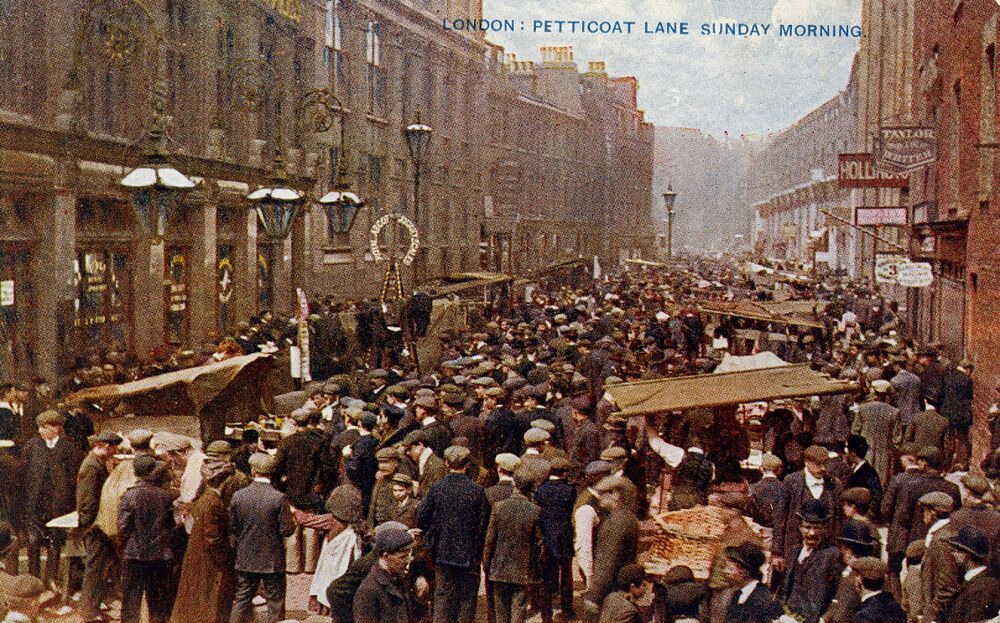Listen: Marion, Alex Moss, Maria Driffil
Petticoat Lane is one of London's oldest street markets, situated on the border of the City and the East End of London. The market arrived here in the late eighteenth century when 'old clothes' traders, principally Jewish, moved eastwards from an earlier base at Houndsditch. What is now Middlesex Street was Hog Lane until the late sixteenth century, then Petticoat Lane (referring to prostitution not clothes-selling), until after 1800, but the market, which has long extended to and principally survives on Wentworth Street, is still known locally as Petticoat Lane or more often just as 'The Lane'.
The market stretched across the area, spreading into many side streets and small alleyways off Middlesex Street and Wentworth Street. From the 1840s onwards Petticoat Lane came to be celebrated as the great Jewish market. 'Every Jewish luxury' could be obtained there (Charles Dickens, Dictionary of London , 1879) including: 'smoked salmon… Dutch cucumbers pickled in salt and water… herrings steeped in brine… the "stuffed monkey", a special pudding made of eggs and ground almonds'… "kosher" meat and unleavened cakes used at the Feast of the Passover', alongside general household goods, tools, second-hand clothes, live poultry and rags amongst many other items.
By the late nineteenth century the market had become the place to buy cheap mass-produced clothes, most of which had been made in the area in Jewish sweatshops. The Victorian market had a reputation as a dangerous place, possibly due to antisemitic attitudes at the time. Jewish traders established the Sunday market due to restrictions of working on the Sabbath. However, Sunday trading was unpopular with non-Jewish locals and outsiders, and there were numerous attempts to close down the Sunday market, with buses and fire engines being driven through the crowds in an attempt to break things up. Mike Stern, a local Jewish trader and leader of the Petticoat Lane stallholders and Stepney Street Traders Association, led a successful campaign in 1936 to secure an Act of Parliament to approve Sunday trading.
'Oh, the atmosphere in the market in those days was absolutely amazing. Half the traders couldn't speak the language but they were all characters. They would sell their wares in such a way that you just had to stand and stare and watch and listen. It was a proper day out. Characters like Prince Monolulu walking through the market, 'I've gotta horse... I've gotta horse.'
Ivan Kingsley (Sandys Row member and Petticoat Lane trader)
Even when most Jews moved out of the area many would return to their 'beloved Lane' on Sundays, to buy Jewish food, to gossip and catch up with friends. It was more than just a market, it was a meeting place, an institution, famous throughout the world for its vibrant street life; the cries of the auctioneers and vendors, the banter, the colour and the smells, the great mix of Yiddish and cockney culture. People came for miles just to experience the place. One of the most popular sites was the crockery-sellers, who would throw entire china services into the air, catching them unbroken on the way down. Second- hand clothes dealer Al Martin would attract hundreds to his pitch outside Whitechapel Baths in Goulston Street with his lively banter and bargains. Others remember Tubby Isaacs jellied eel stall at the Aldgate end of Goulston Street, Mossy Marks deli famous for its smoked salmon and schmaltz herring on the corner of Wentworth Street and Toynbee Street, the legendary salt-beef sandwiches from Barnett's butcher shop, as well as local characters such as the eccentric racing tipster Prince Monolulu and showmen like Mike Stern with his Shakespearian quotes.
Cite This Article
Petticoat Lane Market, jewisheastendmemorymap.org?feature_type=point&id=36, accessed December 2025.

